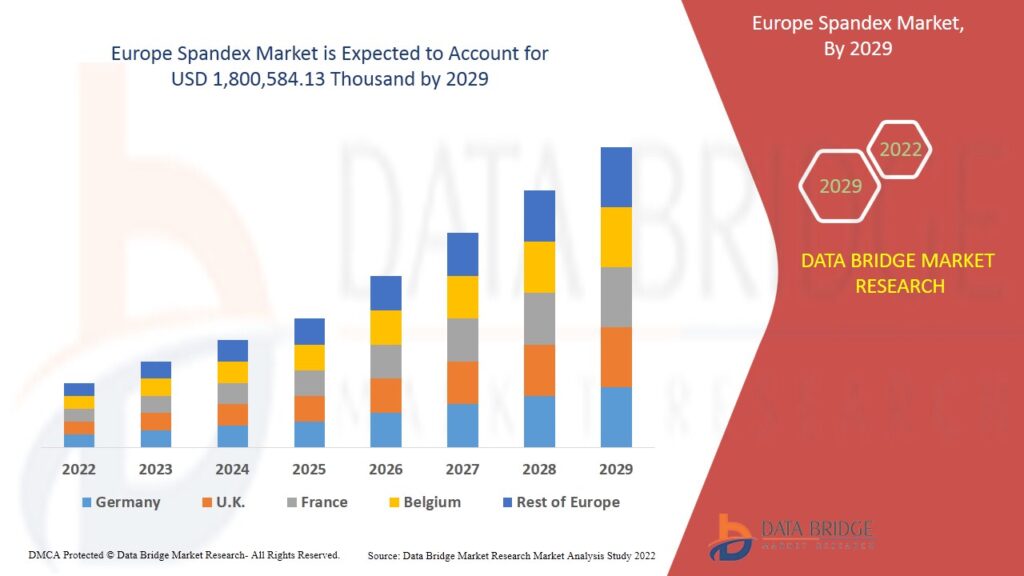Sustainability and Innovation Drive Growth in the Europe Spandex Market
The Europe spandex market is undergoing a notable transformation, shaped by consumer demand for comfort, sustainability, and performance in clothing and textiles. Spandex—also known as elastane or Lycra—is a synthetic fiber celebrated for its exceptional elasticity. Found in everything from activewear to medical textiles, spandex has become a staple in modern fabric technology. In Europe, the market is evolving rapidly due to shifting fashion trends, environmental regulations, and advancements in textile manufacturing.
Market Overview
As of 2024, the Europe spandex market is valued at approximately USD 1.1 billion, with a projected compound annual growth rate (CAGR) of 4.5% to 6.5% through 2030. The region represents a key segment of the global spandex market, thanks to its robust textile industry, high-performance apparel demand, and progressive sustainability goals.
Leading countries in the European spandex market include:
-
Germany – A hub for technical textiles and innovation.
-
Italy – Known for luxury fashion and high-quality fabric production.
-
France, Spain, and the UK – Major contributors through fashion, sportswear, and retail sectors.
-
Eastern Europe – Growing manufacturing base for cost-effective production.
Key Market Drivers
1. Growing Demand for Athleisure and Activewear
One of the most significant drivers of spandex consumption is the continued popularity of athleisure—a fashion trend blending athletic and casual wear. Stretchability and comfort are essential features of activewear, and spandex provides both. European consumers are increasingly seeking versatile clothing that suits fitness, travel, and everyday wear.
2. Comfort-Centric Fashion
Comfort is no longer an option; it’s an expectation. Whether it’s denim, underwear, formal wear, or maternity clothing, spandex is used to create stretch fabrics that enhance wearability and fit. The demand is particularly strong among aging populations who prioritize ease of movement.
3. Medical and Healthcare Applications
Spandex is widely used in compression garments, bandages, and orthopedic support products. With a growing elderly demographic and rising focus on preventive healthcare, demand in this segment is expected to rise.
4. Eco-Conscious Consumer Behavior
Environmental awareness in Europe is high, pushing both brands and manufacturers to seek sustainable alternatives. Bio-based spandex, recycling technologies, and closed-loop production systems are gaining traction.
5. Technological Advancements in Textile Manufacturing
Digital knitting, seamless garment production, and 3D weaving technologies allow for better integration of spandex into complex garments. These innovations also reduce waste and improve production efficiency.
Market Challenges
Despite its strong outlook, the European spandex market faces several challenges:
-
Environmental Concerns: Traditional spandex is petroleum-based and not biodegradable, posing concerns in a region that prioritizes sustainability.
-
Raw Material Volatility: The price of spandex is influenced by fluctuations in raw materials like PTMEG (polytetramethylene ether glycol), which are linked to global oil prices.
-
Competition from Alternative Materials: While spandex remains unmatched in elasticity, new stretch fibers and textile blends are being developed to reduce environmental impact.
-
Stringent Regulations: The European Union’s REACH (Registration, Evaluation, Authorisation and Restriction of Chemicals) framework imposes strict standards on chemical usage, which affects textile production and sourcing.
Segment Analysis
1. By Application
-
Apparel: Dominates the market, with applications in sportswear, intimates, denim, and casualwear.
-
Medical: Compression garments, braces, and surgical textiles.
-
Industrial: Limited but growing use in automotive textiles and specialty protective wear.
2. By Fabric Type
-
Woven Fabrics: Provide shape retention in formal and tailored garments.
-
Knitted Fabrics: Popular in activewear and casualwear for greater flexibility and comfort.
-
Blended Fabrics: Spandex is often blended with cotton, polyester, or nylon to enhance stretchability while retaining other fabric properties.
Sustainability Trends in the Spandex Market
Europe is leading global efforts to make the textile supply chain more sustainable. This is directly influencing spandex production and usage.
-
Bio-Based Spandex: Companies are developing spandex fibers derived from renewable sources like corn-based PTMEG.
-
Recycled Elastane: Brands are exploring the use of post-industrial and post-consumer elastane waste in new textiles.
-
Eco-Certifications: Certifications like OEKO-TEX® and GRS (Global Recycled Standard) are increasingly required by European retailers.
-
Water and Energy Reduction: Manufacturers are investing in closed-loop systems and chemical recycling to lower environmental impact.
Competitive Landscape
The Europe spandex market is competitive, featuring both global producers and regional manufacturers. Key players include:
-
Hyosung Corporation (South Korea): One of the largest spandex producers globally, with a growing focus on sustainable solutions like creora® bio-based spandex.
-
The LYCRA Company (U.S.): Known for innovation in comfort and performance fibers, including LYCRA® T400 and LYCRA® EcoMade.
-
Asahi Kasei Corporation (Japan): Produces Roica™ spandex, offering eco-friendly variants with recycled content.
-
Indorama Ventures (Thailand): A major polyester and spandex supplier with global operations.
-
European Niche Players: Several smaller firms focus on local production with sustainability as a differentiator.
Future Outlook
The Europe spandex market is poised for steady growth and innovation over the next decade. Several trends are expected to shape its future:
-
Sustainable Product Innovation: The shift toward bio-based and recycled spandex will accelerate as retailers commit to circular economy goals.
-
Reshoring and Localized Production: To reduce reliance on imports and improve responsiveness, European manufacturers may scale up regional production.
-
Smart Textiles: Integration of spandex with wearable technology (e.g., fitness sensors, heating elements) will open new application areas.
-
Circular Business Models: Brands will increasingly adopt take-back and textile recycling programs that require compatible and recyclable fibers like spandex.
Conclusion
The Europe spandex market reflects a broader shift in the textile and fashion industries—toward comfort, performance, and sustainability. As brands and consumers alike prioritize these attributes, demand for innovative and eco-conscious spandex solutions is expected to grow. Manufacturers that embrace green technology, regulatory compliance, and product versatility will be well-positioned to lead in this evolving and competitive landscape.
Get more Details
https://www.databridgemarketresearch.com/reports/europe-spandex-market






